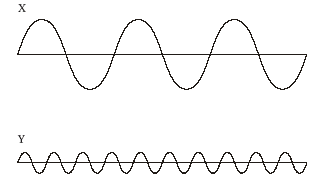
8L Quick Quiz
8La
1 Sound is caused by:
A waves.
B vibrations.
C heat.
D air.
2 The sound of an aircraft taking off is very:
A quiet.
B high.
C soft.
D loud.
3 The sound of a referee’s whistle is:
A soft.
B high.
C low.
D quiet.
4 Sound travels in air because:
A air particles stay still.
B the wind blows it.
C particles pass on vibrations.
D electricity sends it through the air.
8Lb
1 The pitch of a sound is:
A how high or low it sounds.
B how loud or quiet it it.
C how much energy it carries.
D how long the sound lasts.
2 Frequency:
A is the height of the waves.
B is the number of waves per second.
C is measured in metres.
D affects how loud a sound is.
3 A loud sound is produced by waves with:
A a high pitch.
B a high frequency.
C a large amplitude.
D a small amplitude.
4 Look at these drawings of waves. Which statement is true?

A Y has the highest amplitude.
B Y has the longest wavelength.
C X has the highest frequency.
D Y has the highest frequency.
8Lc
1 Which statement is not true?
A light and sound both travel as waves.
B sound travels at the same speed as light.
C light travels faster than sound.
D light and sound can both be reflected.
2 Sound can travel through:
A gases and space.
B a vacuum.
C solids and liquids only.
D solids, liquids and gases.
3 Which does sound travel through the quickest?
A air
B water
C iron
D space
4 Sound travels fastest in solid materials which have particles that are:
A wide apart.
B close together.
C very hot.
D able to move around freely.
8Ld
1 The ear changes sound energy into:
A light energy.
B electrical energy.
C noise energy.
D heat energy.
2 Which part of the ear changes sound energy into another form of energy?
A the cochlea
B the ear drum
C the auditory nerve
D the small bones
3 Which structure takes signals (impulses) to the brain?
A the cochlea
B the ear drum
C the auditory nerve
D the ear piece
4 The ear can be blocked by wax. Which statement is true?
A This causes permanent deafness because the ear drum cannot vibrate.
B This causes temporary deafness because the ear drum cannot vibrate.
C This causes permanent deafness because the cochlea cannot vibrate.
D This causes temporary deafness because the cochlea cannot vibrate.
8Le
1 The loudness of a sound can be measured using:
A a barometer.
B a sound intensity meter.
C an ammeter.
D a voltmeter.
2 The unit for loudness of sound is:
A volume.
B metre.
C joule.
D decibel.
3 Which statement is not true?
A Quiet sounds can harm the ears.
B The sound near to disco speakers can be louder than a road drill.
C The eardrum can be damaged by personal stereos.
D A noisy factory can permanently damage the ears.
4 Sound is less likely to get out of a room which has:
A a wooden floor.
B black walls.
C soft curtains and a carpet.
D spotlights.